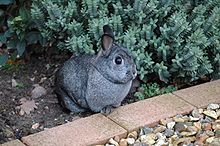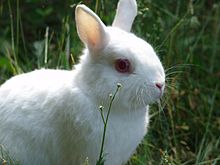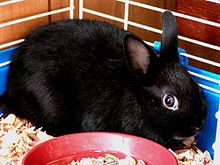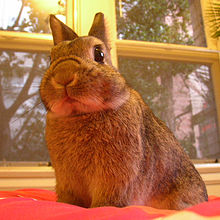- Netherland Dwarf
-
- This article concerns a particular breed of rabbit, the Netherland Dwarf. For information on domestic rabbits in general, see Domestic rabbit.
 A pet Netherland Dwarf.
A pet Netherland Dwarf.
The Netherland Dwarf is a popular breed of domestic rabbit (Oryctolagus cuniculus) originating in the Netherlands. Smaller than most rabbit breeds, Netherland Dwarf rabbits weigh 500 g to 1.6 kg (1.1 lbs to 3.5 lbs) and are usually kept as pets or exhibition animals. They are not typically used as sources of meat or fur because of their small size.(3 in.)
Most rabbits sold in rabbit shows are Netherland Dwarfs, Netherland Dwarf-derived breeds (often referred to simply as dwarf breeds), or Netherland Dwarf crosses. Their popularity as pets stems from their babyish appearance and their smaller cage space requirement compared to larger rabbit breeds. A lot of people also use Netherland Dwarfs for showing.
Contents
History
The Netherland Dwarf breed was first produced in the Netherlands in the early 20th century. Small Polish rabbits were bred with smaller wild rabbits;[1] after several generations the resulting animal was a very small domestic rabbit available in a wide variety of colors and patterns. Netherland Dwarfs were first imported into the United Kingdom in 1948.[1] In the 1960s and 1970s the United States imported its first Netherland Dwarf rabbits. The breed was accepted by the American Rabbit Breeders' Association in 1969 using a modification of the British standard.[1]
Early dwarfs, even into the 1970s and 1980s, had fearful and sometimes aggressive temperaments. This was a result of breeders selecting wild breeding animals for their size. The first dwarf rabbits behaved more like these wild rabbits than domestic animals and were not good pets. However, through generations of selective breeding, the modern Netherland Dwarf has become a gentle, friendly pet rabbit, though it still retains a more energetic disposition than larger breeds.
Appearance
Netherland Dwarfs' heads and eyes are disproportionately large with respect to their bodies, and their ears are tiny and carried high on the head. Additionally, their faces are rounded and shortened. These features, a part of the animals' dwarfism, cause them to look infantile even into adulthood.
Dwarf crosses frequently retain some of these characteristics, depending on the breed the dwarf is crossed with. However, crosses rarely look as babyish as the purebred dwarfs and are usually somewhat larger.
Purebred Netherland Dwarfs come in a wide variety of colors, including Himalayan, Black, Blue, Chocolate, Lilac, Smoke Pearl, Sable Point, Tortoiseshell, Chestnut, Siamese Sable, Opal, Lynx, Squirrel, Chinchilla, Otter, Tan, Silver Marten, Sable Marten, Smoke Pearl Marten, Orange, Fawn, Steel, Broken, Blue-Eyed White and Ruby Eyed White.[1] Other colors (including mismarks) exist in non-show-quality Netherland Dwarfs and in dwarf mongrel rabbits.
Netherland Dwarfs as pets
Behavior Netherland dwarf rabbits have the same basic behavioral traits as dogs or cats. They can be litter-trained, but success varies amongst trainers of any breed.
Netherland Dwarfs have a reputation of being skittish, wild, and/or of poor temperament. This is a leftover stereotype from the beginnings of the breed, when temperament wasn't the best. This has changed through selective breeding, making Dwarfs a docile breed. There are always exceptions, however, and there are testy individuals out there. In general, the Netherland Dwarf is curious and gentle. Those that are handled often learn to seek out human contact and enjoy companionship.
A well-bred Netherland Dwarf makes an excellent pet for both adults and children. They are hardy and, while small, are able to keep up with reasonable play and handling.
Diet
Like other domestic rabbits, dwarf rabbits have a sensitive digestive system that is less hardy than their wild rabbit cousins. Leafy vegetables such as lettuce and cabbage fed in excess can give them health problems, such as diarrhea. Young rabbits, up until about six months of age, should not be given vegetables for this reason. Adults can be fed safe fruits and veggies in moderation. In addition, sudden changes to a dwarf rabbit's diet can cause digestive problems, but it generally only lasts a few days and usually causes no real harm/lasting damage.
A very important aspect of rabbit care is proper diet. Many owners unintentionally fail at this point and that often spells disaster for their pet. Netherland Dwarfs have a digestive system even more sensitive than most breeds. The best diet consists of fresh, good quality rabbit pellets fed in limited amounts. It is crucial that the pellets be fresh and stored for no longer than eight weeks, do not use pellets which are moldy or have been contaminated. As pellets age they lose important nutrients, and a rabbit’s system will become susceptible to disease. The owner should also check the label for the percentages of protein, fiber, and fat. The National Research Council lists minimum rabbit nutrient requirements for a maintenance diet as 14% crude fiber, 2% fat, and 12% protein. It is best to feed a pellet that is higher in fiber (18-20%) and lower in protein (14-15%) and fat (2-3%) to a pet rabbit. Once you find a good brand, stick with it; frequent changes in diet can cause digestive problems. If you need to change brands, be sure to mix the new feed in with the old and increase the amount of new to old over a week's time so the rabbit can adjust.
Netherland Dwarfs generally don't require much feed. A small handful each day is usually enough, but it is important to adjust for each individual to avoid malnourishment/obesity. It is also important not to overfeed a Netherland Dwarf. Hay, however, can be given in unlimited amounts.[2] A traditional ramekin dish full of complementary food and free access to water is always required.
Dwarf breeds
Rabbit breeds derived from breeding larger rabbits with the Netherland dwarf are known as dwarf breeds. Most smaller breeds, like the Mini-Rex, the Jersey Wooly, and the Holland lop, are results of such breedings. Generally dwarf breeds are slightly larger than the typical Netherland dwarf, not growing larger than 4 to 5 lb (1.8 to 2.3 kg). Most have shortened faces compared to larger rabbits, and some even preserve the rounded head, large eyes, or small ears of the Netherland dwarf.These features make them look little.
Most dwarf breeds are intended to bring a specialized characteristic, such as a specific fur type, into a smaller rabbit. Mini-Rex were created through the breeding of dwarfs with Rex rabbits, a fur breed with a short, plush coat, and retain both the dwarf's size and the Rex fur. Jersey Woolies are a dwarf version of the Angora rabbit, a wool-producing breed. Lop-eared rabbit breeds, interbred with dwarfs, were used to create Holland Lop. Despite its name, the Mini Lop is not a dwarf breed.
Breeding
When two "true dwarfs" (both buck and doe) are bred, the genetic pattern which makes them "true dwarfs" (Dwdw) ensures that a percentage of their offspring will inherent the lethal genetic combination DwDw. These offspring, often called "peanuts" by rabbit breeders, are destined to struggle with life for up to three weeks, and then to die. Reasons behind the death are unknown, but it is believed that peanuts have underdeveloped digestive tracts. The condition is 100% fatal, despite claims of some peanuts living to adulthood. Many ethical breeders humanely euthanize peanuts upon finding them soon after birth. Peanuts are easily distinguished from non-peanuts; they have extremely pinched hindquarters, a bulbous head, and their ears are often set further back than normal (sometimes almost onto the neck).
If two true dwarfs are bred, the statistical result will be 25% fatal 25% false, and 50% true. The actual numbers of true/false/peanuts in a real litter varies. "False Dwarfs" tend to have longer bodies, longer/larger ears, longer faces, and are often heavier than the 2.5 pound maximum weight for showing. While false dwarfs do not make good show rabbits, does from a good background are vital to a breeder's program. They have the same "good genes" as a true dwarf and are capable mothers, often having larger and more successful litters than true dwarfs. False dwarfs are easily judged for quality as the traits are generally the same, only bigger. Ear thickness/shape, fullness of hindquarter, topline, and other traits are the same.
It is common practice amongst Netherland Dwarf breeders to breed a proven show quality true dwarf buck to a quality false dwarf doe. This eliminates the chance of peanuts and yields quality offspring. The chances of false dwarfs is higher, but those offspring generally go toward breeding (some false dwarf bucks have proven themselves valuable to a breeding program) or are sold as pets.
Notes
- ^ a b c d American Rabbit Breeders Association (2000). Official Guide Book: Raising Better Rabbits & Cavies. Bloomington, IL: American Rabbit Breeders Association, Inc.. pp. 65.
- ^ http://www.bio.miami.edu/hare/diet.html
See also
- Dwarf rabbit
- List of rabbit breeds
- American Rabbit Breeders' Association
- American Netherland Dwarf Rabbit Club http://www.andrc.com
- Dwarf Rabbits Articles http://www.mylovelybunny.com
Categories:- Rabbit breeds
- Pet rabbits
- Animal breeds originating in the Netherlands
Wikimedia Foundation. 2010.






